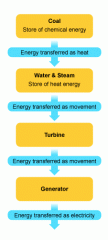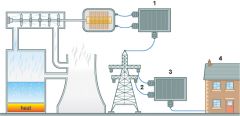![]()
![]()
![]()
Use LEFT and RIGHT arrow keys to navigate between flashcards;
Use UP and DOWN arrow keys to flip the card;
H to show hint;
A reads text to speech;
11 Cards in this Set
- Front
- Back
|
Q1. Fossil fuels are renewable or non-renewable? Q2. Three examples of fossil fuels are..... Q3. What type of energy do these resources release when burned? |
A1. Non-renewable A2. coal, oil and natural gas. A3. Heat |
|
|
Can you describe the energy transfer for the generation of electricity from a fossil fuel?
|

|
|
|
Q1. What is a disadvantage of fossil fuels compared to a fuel like wood? Q2. Coal and oil release sulfur dioxide gas when they burn, give any problems this may cause. |
A1. They are non-renewable energy resources: their supply is limited and they will eventually run out.
A2. Causes breathing problems for living creatures and contributes to acid rain. |
|
|
Q1. Fossil fuels release carbon dioxide when they burn, give the main problem this leads to?
Q2. Give a way to prevent carbon dioxide building up in the atmosphere. |
A1. Adds to the greenhouse effect and increases global warming.
A2. Carbon capture and storage |
|
|
Q1. The main nuclear fuels are .....
Q2. Give an advantage of nuclear fuels. Q3. Give a disadvantage of nuclear fuels. |
A2. Unlike fossil fuels, nuclear fuels do not produce carbon dioxide or sulfur dioxide A3. They are non-renewable energy resources. Nuclear waste remains radioactive and is hazardous to health for thousands of years. It must be stored safely. |
|
|
Q1. Like the wind, water can be used to drive turbines directly.
Give an advantage of water energy. Q2. Give a disadvantage. |
A1. Renewable resource with no fuel costs. A2. Tidal destroys a habitat. Hydroelectric can cause floods. |
|
|
Q1. Hot water and steam from deep underground can be used to drive turbines: this is called ........
Q2. An advantage of this is.... Q3. A disadvantage is...... |
A1. geothermal energy.
A2. no fuel costs. No harmful polluting gases are produced. A3. Most parts of the world do not have suitable areas. |
|
|
Q1. Solar cells are devices that convert light energy directly into......
Q2. Give any advantages of solar energy. Q3. Give any disadvantages of solar energy. |
A1. electrical energy. A2. No fuel costs. No harmful polluting gases are produced. A3. Expensive and inefficient. Solar cells do not work at night. |
|
|
Power stations fuelled by fossil fuels or nuclear fuels are reliable sources of energy. Put coal, oil, natural gas and uranium in order of start up time, going from short to long.
|
1. Gas-fired station (shortest start-up time)
2. Oil-fired station 3. Coal-fired station 4. Nuclear power station (longest start-up time). |
|
|
The National Grid Q1. A transformer is an electrical device that...... Q2. A transformer that:increases the voltage is called a ...... Q3. A transformer that: decreases the voltage is called a |
A1. changes the voltage.
A2. step-up transformer A3. step-down transformer. |
|

Give the next 4 stages that electricity from a power station travels.
|
1. Step-up transformers
2. High voltage transmission lines 3. Step-down transformers 4. Consumers, for example homes, factories and shops. |

